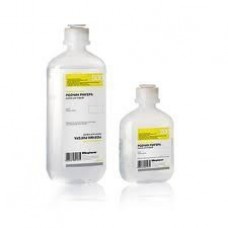Expiration date: 12/2026
Trade name: ringer's Solution
Dosage form: solution for infusions
Description: clear colorless solution
Structure
1 liter of the solution contains as an active substance: sodium chloride 8, 60 g, calcium chloride 0, 33 g, potassium chloride 0, 30 g.
Excipients - sodium hydroxide, hydrochloric acid, water for injection, which corresponds to: sodium (Na+) - 147, 00 mmol, potassium (K+)- 4, 00 mmol, calcium (Ca2+)- 2, 25 mmol, chloride (Cl-)-155, 60 mmol. Theoretical osmolarity: 309 mosmol.
Pharmacotherapeutic group: rehydrating agent.
PBX code: [B05VB01].
Pharmacological properties
Ringer's solution compensates for the loss of extracellular fluid and basic electrolytes (sodium, potassium, calcium) and chlorides.
Indications for use
As a plasma replacement agent when there is no need to replace red blood cells, including shock, collapse, burns, frostbite, prolonged vomiting, diarrhea. The drug is used for dehydration of various Genesis, hyponatremia, hypovolemic shock (as auxiliary therapy), and metabolic acidosis with fluid loss.
Contraindications
Hypersensitivity to the components of the drug, decompensated heart failure, pulmonary edema, brain edema, oliguria, anuria, acidosis, hypervolemia, hyperchloremia, hypercalcemia, hypernatremia, concomitant therapy of GCS.
With caution - heart failure, hypertension, impaired liver or kidney function.
Dosage and administration
Enter in/in a drip at a dose of 500 to 1000 ml /day, the average rate of administration - 3, 0 ml/kg of body weight per hour or 70 drops/min or 250 ml/hour. The total daily dose is up to 2-6 % of body weight.
Side effect:
When a large volume of the solution is administered, acidosis may develop.
If the dose is not sufficiently high, there may be a violation of the input-electrolyte balance, including hypovolemia, hypernatremia, hyperkalemia, hypercalcemia, hyperchloremia.
Special instruction:
With prolonged use, it is necessary to monitor the concentration of electrolytes in plasma and daily diuresis.
Due to the high level of chloride ions, long-term use of the drug is not recommended.
Drug interaction
It is possible to increase the retention of sodium in the body while taking the following medications: non-steroidal anti-inflammatory drugs, androgens, anabolic hormones, estrogens, corticotropin, mineralocorticoids, vasodilators or ganglioblockers.
When taken with potassium-sparing diuretics, ACE inhibitors, and potassium medications, the risk of hyperkalemia increases.
In combination with cardiac glycosides, the likelihood of their toxic effects increases.
Form release
500 ml of the solution in a plastic bottle. 1 bottle with instructions for use in a pack of cardboard or 10 bottles with instructions for use in a cardboard box (packaging for hospitals).
Storage conditions
List B.
Store at a temperature of 15 ° C to 25 ° C
Shelf life
Shelf life: 3 years.
Do not use after the expiration date indicated on the package.


